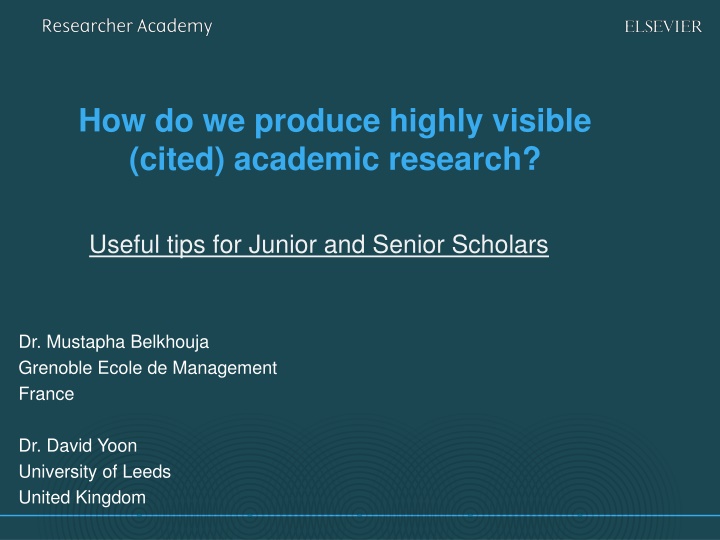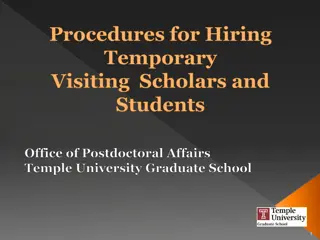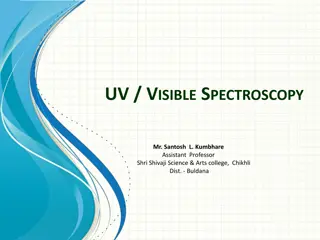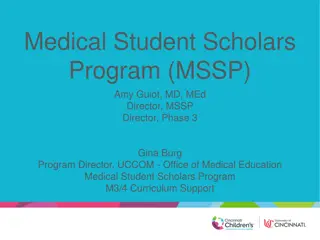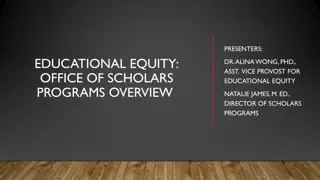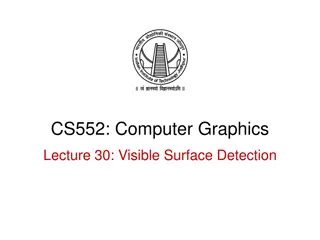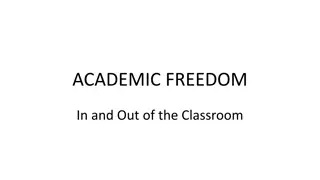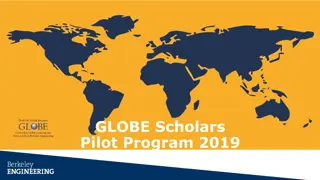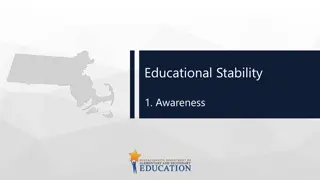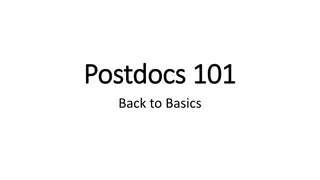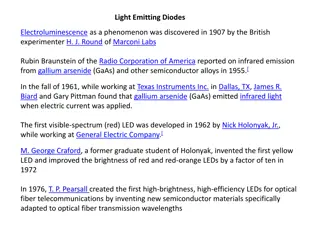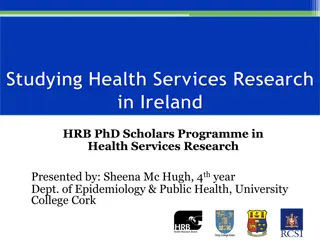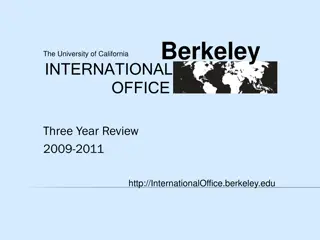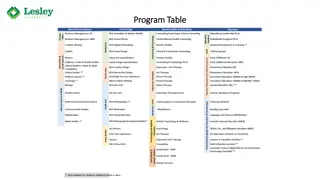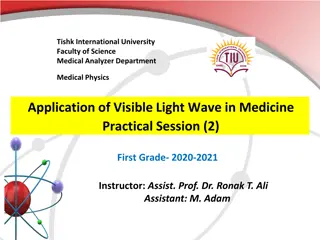Producing Highly Visible Academic Research: Tips for Scholars
Producing highly visible and cited academic research is essential for academic progress. Learn valuable tips from experts on enhancing academic visibility through strategic collaboration, multidisciplinarity, and navigating institutional pressures. Explore key publications and insightful outcomes to boost your research impact.
Download Presentation

Please find below an Image/Link to download the presentation.
The content on the website is provided AS IS for your information and personal use only. It may not be sold, licensed, or shared on other websites without obtaining consent from the author.If you encounter any issues during the download, it is possible that the publisher has removed the file from their server.
You are allowed to download the files provided on this website for personal or commercial use, subject to the condition that they are used lawfully. All files are the property of their respective owners.
The content on the website is provided AS IS for your information and personal use only. It may not be sold, licensed, or shared on other websites without obtaining consent from the author.
E N D
Presentation Transcript
How do we produce highly visible (cited) academic research? Useful tips for Junior and Senior Scholars Dr. Mustapha Belkhouja Grenoble Ecole de Management France Dr. David Yoon University of Leeds United Kingdom
About the speakers Associate Professor at Grenoble Ecole de Management (France) Ph.D. in Economics Research interests: Academic visibility, Reputation, Knowledge diffusion and International business Webpage: https://en.grenoble- em.com/annuaire/mustapha-belkhouja Assistant Professor at Leeds University Business School, University of Leeds (UK) Ph.D. in Management Research interests: Social evaluations in knowledge- intensive industries, Liability of foreignness in international business, Technological learning in megaprojects. Webpage: https://business.leeds.ac.uk/about-us/our- people/staff-directory/profile/hyungseok-david-yoon/ | 2
Personal Motivation Collaboration Internal vs. External Multidisciplinarity Specialization vs. Diversification | 3
Institutional Pressure Producing high-impact research is a growing expectation of academics. Not only publishing in top journal matters, but also the number of (forward) citations! Publish or Perish -> Visible or Vanished While not all highly cited research papers produced by academics equate to their impact in a societal sense, it is not difficult to argue that they have been very important for academic progress. | 4
Speakers Key Publications Main source of our Webinar presentation Belkhouja, M., & Yoon, H. D. (2018). How does openness influence the impact of a scholar s research? An analysis of business scholars citations over their careers. Research Policy, 47(10), 2037- 2047. (https://doi.org/10.1016/j.respol.2018.07.012). Other relevant publications of the presenters (2018). A Bibliometric Analysis of the Knowledge Exchange Patterns Between Major Technology and Innovation Management Journals (1999 2013). Journal of Product Innovation Management, 35(1), 2-8. (2018). A Twenty Year Citation Analysis of the Knowledge Outflow and Inflow Patterns from the Journal of Product Innovation Management. Journal of Product Innovation Management, 35(6), 854-863. (2015). A Note On The Evolution Of The French Management Scholarship, 1994-2014. M@n@gement, 18(3), 194-204. | 5
Learning Outcomes By the end of the Webinar you should be able to answer the following questions: L1: How does your research background (e.g. unidisciplinary vs. multidisciplinary) affect the individual s citations? L2: How does your collaboration (e.g. internal vs. external) affect the individual s citations? L3: Are there differences between how early career researchers and established researchers should conduct research to attract more citations? | 6
Key Terms Visibility: Number of citations Cognitive openness: Multi-disciplinary background of individuals Structural openness: Proportion of external collaborations of individuals Career age: Junior vs. Senior | 7
Conceptual Model Cognitive openness: The number of different disciplines a scholar has covered up to the current year L1 Impact of scholars research: Yearly citations Scholar s career stage: The length of a scholar s research career up to the current year L3 Structural openness: The ratio between the number of external collaborations and the number of collaborations of a scholar up to the current year L2 | 8
Data and Analytical Approach Scopus & Web of Science (1994-2013) 159,169 articles 320 journals in business and Management 20 disciplines (ABS journal guide classification) 35,296 authors 281,930 author-year observations Generalizability of our analysis: Multi-disciplinary research and external collaboration are becoming more important for many subjects (e.g. Life Science, Physical Science, Earth and Space, etc.) that require a large scale of resources (e.g. equipment, finance, human capital) to generate ground breaking research. | 9
Results: Learning Outcome 1 Yearly citations Constant Model 1 -1.58*** (0.07) 0.21*** (0.00) 0.11*** (0.00) 0.56*** (0.00) 0.04*** (0.00) 0.13*** (0.00) 0.24*** (0.01) 0.04*** (0.00) 0.07*** (0.00) 0.02*** (0.00) Model 2 -1.53*** (0.07) 0.20*** (0.00) 0.11*** (0.00) 0.48*** (0.00) 0.04*** (0.00) 0.12*** (0.00) 0.26*** (0.01) 0.02*** (0.00) 0.08*** (0.00) 0.03*** (0.00) 0.11*** (0.01) 0.14*** (0.03) 0.17*** (0.01) -0.01*** (0.00) -0.18*** (0.02) Publications FT45 publications Prior citations High-status institution Unique co-authors Repeated co-authorship Mobility Co-authors citations High-status co-authors Cognitive openness Structural openness Career age Cognitive openness squared Structural openness squared Cognitive openness Career age Structural openness Career age Cognitive openness squared Career age Structural openness squared Career age Yes Yes Year dummies Number of observations Number of authors Log likelihood Chi-square 281,930 35,296 -668,015.82 506,408.18 281,930 35,296 -667,741.27 502,544.14 | 10
Multidisciplinary Background and Visibility 1.85 1.83 1.81 1.79 1.77 Yearly citations 1.75 1.73 1.71 1.69 1.67 1.65 Low High Cognitive openness | 11
Key Takeaways Benefits of multidisciplinary background Exposure to heterogeneous knowledge domains improves the novelty and quality of individual research output, as cognitive diversity stimulates new elaborations and trials (Rodan and Galunic, 2004): Audiences expect new ideas or insights that are produced by researchers with a multidisciplinary background (Schilling and Green, 2011; Uzzi et al., 2013) Pitfalls of multidisciplinary background Over-reliance on heterogeneous knowledge base makes recombination task difficult (Lee et al., 2015): Covering multiple knowledge domains limits mastery and dilutes identity, resulting in a jack-of-all-trades who is a master of none of them (Leahey et al., 2017) | 12
Results: Learning Outcome 2 Yearly citations Constant Model 1 -1.58*** (0.07) 0.21*** (0.00) 0.11*** (0.00) 0.56*** (0.00) 0.04*** (0.00) 0.13*** (0.00) 0.24*** (0.01) 0.04*** (0.00) 0.07*** (0.00) 0.02*** (0.00) Model 2 -1.53*** (0.07) 0.20*** (0.00) 0.11*** (0.00) 0.48*** (0.00) 0.04*** (0.00) 0.12*** (0.00) 0.26*** (0.01) 0.02*** (0.00) 0.08*** (0.00) 0.03*** (0.00) 0.11*** (0.01) 0.14*** (0.03) 0.17*** (0.01) -0.01*** (0.00) -0.18*** (0.02) Publications FT45 publications Prior citations High-status institution Unique co-authors Repeated co-authorship Mobility Co-authors citations High-status co-authors Cognitive openness Structural openness Career age Cognitive openness squared Structural openness squared Cognitive openness Career age Structural openness Career age Cognitive openness squared Career age Structural openness squared Career age Yes Yes Year dummies Number of observations Number of authors Log likelihood Chi-square 281,930 35,296 -668,015.82 506,408.18 281,930 35,296 -667,741.27 502,544.14 | 13
Collaboration and Visibility 1.78 1.77 1.76 1.75 Yearly citations 1.74 1.73 1.72 1.71 1.7 Low High Structural openness | 14
Key Takeaways Benefits of external collaboration Researchers can enhance their research impact by gaining access to external parties in order to obtain complementary resources (Nahapiet and Ghoshal, 1998): Access to databases, expertise, prestige, funds, equipment, and language skills that those scholars might lack (Eisend and Schmidt, 2014; Katz and Martin, 1997) Pitfalls of external collaboration Development of novel research projects entails experiencing high levels of ambiguity and uncertainty, which necessitates ongoing coordination of task activities (Hoegl and Proserpio, 2004): Difficult to allocate the proper level of attention and time to implement and produce high-impact research (Koput, 1997) | 15
Results: Learning Outcome 3 Yearly citations Constant Model 3 -2.04*** (0.07) 0.19*** (0.00) 0.11*** (0.00) 0.51*** (0.00) 0.04*** (0.00) 0.11*** (0.00) 0.22*** (0.01) 0.02*** (0.00) 0.08*** (0.00) 0.03*** (0.00) 0.51*** (0.02) 0.77*** (0.07) 0.39*** (0.01) -0.07*** (0.00) -0.68*** (0.05) -0.20*** (0.01) -0.37*** (0.03) 0.03*** (0.00) 0.29*** (0.03) Yes 281,930 35,296 -662,066.02 485,561.03 Publications FT45 publications Prior citations High-status institution Unique co-authors Repeated co-authorship Mobility Co-authors citations High-status co-authors Cognitive openness Structural openness Career age Cognitive openness squared Structural openness squared Cognitive openness Career age Structural openness Career age Cognitive openness squared Career age Structural openness squared Career age Year dummies Number of observations Number of authors Log likelihood Chi-square | 16
Multidisciplinary Background and Visibility contingent upon Career Age 2.05 2 1.95 1.9 Yearly citations 1.85 Junior scholars Senior scholars 1.8 1.75 1.7 1.65 Low High Cognitive openness | 17
Key Takeaways Moderate level of multi-disciplinary research for junior scholars Exposure to a variety of cognitive or knowledge domains develops research competence and enhances absorptive capacity for junior scholars to generate high-impact research. As newcomers to academia, junior scholars need to build their academic identity (i.e. focusing on their core research domain) to be recognized by their peers. High level of multi-disciplinary research for senior scholars Late-career researchers are likely to be exposed to different knowledge domains than junior scholars (Mannucci and Yong, 2018). Senior scholars have ability and legitimacy to recombine knowledge from different domains that will be well-received by audiences. | 18
Results: Learning Outcome 3 Yearly citations Constant Model 3 -2.04*** (0.07) 0.19*** (0.00) 0.11*** (0.00) 0.51*** (0.00) 0.04*** (0.00) 0.11*** (0.00) 0.22*** (0.01) 0.02*** (0.00) 0.08*** (0.00) 0.03*** (0.00) 0.51*** (0.02) 0.77*** (0.07) 0.39*** (0.01) -0.07*** (0.00) -0.68*** (0.05) -0.20*** (0.01) -0.37*** (0.03) 0.03*** (0.00) 0.29*** (0.03) Yes 281,930 35,296 -662,066.02 485,561.03 Publications FT45 publications Prior citations High-status institution Unique co-authors Repeated co-authorship Mobility Co-authors citations High-status co-authors Cognitive openness Structural openness Career age Cognitive openness squared Structural openness squared Cognitive openness Career age Structural openness Career age Cognitive openness squared Career age Structural openness squared Career age Year dummies Number of observations Number of authors Log likelihood Chi-square | 19
Collaboration and Visibility contingent upon Career Age 1.95 1.9 1.85 Yearly citations 1.8 Junior scholars Senior scholars 1.75 1.7 1.65 Low High Structural openness | 20
Key Takeaways Moderate level of external collaboration for junior scholars Helps to maintain internal ties and build external ties: In addition to internal resources, we can use complementary resources from outside organizational boundaries (i.e. external collaboration) to enhance visibility (e.g. visiting researcher) Internal collaboration for senior scholars Spill-over of senior scholars research leadership: Mentorship role to help other researchers (e.g. junior) at the same institution by promoting their research | 21
Wrap-up (1/2) To enhance your visibility, it is important to consider the basis of the authors knowledge, as well as their co-authors physical locations. Strategies should also be devised to foster the visibility of an individual s research based on the stage of their career. There should be moderate levels of multidisciplinarity and internal / external activity for those who are early in their career, and for established academics our results suggest a high level of multidisciplinary working and local collaboration is the key to enhancing their academic impact. For more information, please read the authors' publication Belkhouja, M., & Yoon, H. D. (2018). How does openness influence the impact of a scholar s research? An analysis of business scholars citations over their careers. Research Policy, 47(10), 2037-2047. (https://doi.org/10.1016/j.respol.2018.07.012) | 22
Wrap-up (2/2) Collaboration Internal vs. External Multidisciplinarity Specialization vs. Diversification | 23
Follow-up Project How diversity (knowledge, geographic, and cultural) influences research teams to publish in top journals and attract citations? Follow us on Mustapha s Mendeley: https://www.mendeley.com/profiles/mustapha-belkhouja2/ David s Mendeley: https://www.mendeley.com/authors/57198835793/ David s Twitter: https://twitter.com/davidhsyoon | 24
Thank you. Ask your questions on: Researcher Academy Mendeley group Follow us on Twitter
